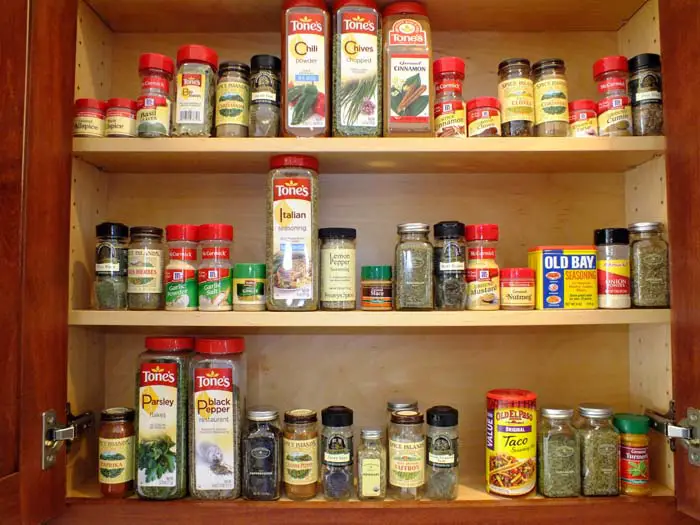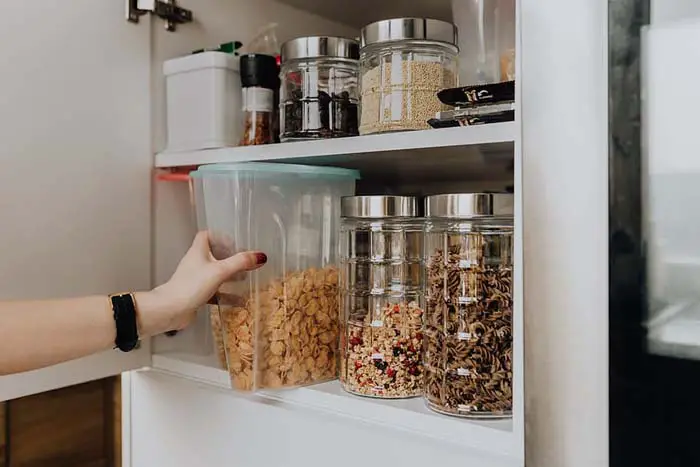When your kitchen pantry is in order, meal prep, baking, and cooking are more fun and efficient. Color-coded, well-organized pantry with uniform storage containers/jars and trays isn’t the only reason people appreciate it.
It’s vital to remember that organizing this area is only half the battle; the other half is actually maintaining it. Many types of pantries exist, including walk-in and built-in shelving pantries, freestanding cabinets, double-door cupboards, and others.
You can store ingredients and dry foods in an organized manner no matter where you keep them. If you don’t want to waste time searching for anything specific or have things fall out of the pantry door when you open it, you’ll need to organize them.
However, there are many ways to have an organized kitchen pantry. In this post, we’ll take the best parts of all of them and show you how to make a really well-organized pantry!
Here are simple steps for organizing your pantry
-
Organize your space
If you start by decluttering, you’ll be able to get rid of useless or undesirable products and truly uncover what you’ve been collecting in your pantry.
You may gift your healthy friend because expired food should be thrown away. For example, any food you bought on an unplanned health kick and would never use again.
Discarding or donating items you don’t use or are broken could be a good idea if you keep them in your pantry to free up some room.
-
Using color codes and labels
The use of color-coded labels is a multipurpose solution for further organizing your pantry in the kitchen. These eye-catching labels brighten the room while making it easier to find and store stuff. For instance, using color codes can help you locate where a particular item is more quickly than reading the label on a particular food item.
It will take some time for you and your family to learn which colors represent different types of food. But once you do, you’ll appreciate how much easier it is to search through a color-coded storage bin to find exactly what you need!
Whatever your pantry size, the most effective way to organize it is by combining all the recommendations above!
-
Using organizing aids—storage bins, trays, and baskets
Some items in your pantry, such as canned goods and packaged foods, cannot be reused. You should effectively store these. In order to keep track of all the different types of food in your pantry, organizing tools like bins, baskets, and trays are essential. Though you can store many canned foods and bottled goods on different shelves or at either end of a shelf, employing these storage solutions in your pantry encourages better order and keeps it from appearing uniform. You may want to consider adding racks inside the door for additional storage. This storage area can store spice bottles and other small food items.
There are many different types of storage containers that you can use in your kitchen. But it’s best to stick to a specific color and theme when purchasing them. You can play with contrasting hues or match them for a more fun-looking pantry.
-
Categorizing food items

You should first categorize your pantry’s food before you can organize it. You may get an idea of how much space or how many strays or shelves you’ll need in your pantry. This will help you keep each type of thing by listing everything in your pantry under the appropriate label.
It’s simple to return the groupings to the pantry once you’ve put them on the bench.
Among the most popular groupings are:
- Snacks
- Baking
- Sauces/condiments/spreads
- Cereals
- Spices, salt, pepper, oils
- Cans
-
You can store snacks in baskets
Packet snacks, cereals, baking ingredients, and nuts store well in Tupperware containers or canisters.
You can use Lazy Susan to store spreads, sauces, and spices.
There are several ways to stack cans. Use a shelf divider with a step-up to make it easier to identify cans.
-
Invest in bottles, jars, and storage containers of the correct sizes
It all depends on what foods you have in the pantry, how many items you can convert to storage aids, and how much space you have in the pantry. If you’re unclear about what you need, list and categorize the pantry products on your kitchen counter. Next, imagine how the jars/containers will fit into the pantry and how they will fit into your pantry.
You can use glass jars if they are airtight and have a suitable seal. Plastic containers made from recycled materials are another option.
The use of clear canisters and jars for storage is highly recommended. They’re not just visually appealing, but they’ll help keep your food fresher for a long time. This is because you can see precisely how much you have left.
Having comparable jars in a variety of sizes is a brilliant idea. For example, you might require a larger canister or jar, while you can store seeds, nuts, and sugar in a smaller container.
In the short term, it might seem like a lot of money to purchase a lot of containers or jars. But it will save you money in the long run if your food stays fresher and is used more often.
Aside from things you regularly use or have heavy or fragile packaging, removing them from their original packaging will help keep your pantry organized.
Small tubs or baskets can keep irregularly shaped things or stray packets from becoming lost. Using these organizational aids, you can keep loose items from getting lost, keep things in order, and hide the messier ones from sight.
In order to get the best pantry storage aids, keep these points in mind:
- If you choose two or three sizes from the same collection, they will look like they belong together.
- Keep a running tally of how many items you plan to store in each container, and note the approximate volume you need.
- In order to discover products more quickly and determine which foods need restocking, clear storage is always the ideal option.
- For ease of use, opt for both secure and easy-to-open containers.
- Adhere to a theme in pattern, style, and material (glass, metal, plastic, etc.).
In order to keep everything in your pantry while also providing a clean and uniform aesthetic for the entire area, you should purchase these storage containers and jars.
Emptying items in the pantry into storage containers- Use organizing aids to organize
The next step is to determine how to make the most efficient use of your organizing tools in order, tidiness, and ease of use. Check that the food products that you can transfer into the jars, bottles, and containers you’ve purchased fit before you begin organizing the pantry. This way, you will know if you have enough space or need to acquire any additional products.
In addition, you must make sure that everything fits inside the pantry without anything sticking out. It may take some time to get your pantry in order, but it will be much easier to keep your kitchen in order once you do!
Maintenance
Your pantry may no longer need much tidiness or rearrangement once you organize it logically and efficiently.
It should be easy to maintain and stay neat and organized if everything has a designated location. Also, keep putting things back where they belong.
Even if you clean the shelves once every six months, it’s a good idea to remove anything that has passed its best-before date and clean the shelves on a regular basis.
Once you’ve cleaned out your pantry and can see everything clearly, you’ll be more likely to make good use of what you have on hand and less likely to misplace items.
Pantry Organizers: What to Look for
Functionality:
Your organizers should be understandable to everyone in your household. You can count on your kids or partner to keep your pantry tidy if you provide them with simple-to-use items. If you have small children at home, you should seek wide open containers or bins with simple flip-up or pop tops. Choose containers with screw-tops or locking lids for an airtight seal if you have teenagers or small children.
Stackability:
In a pantry, every inch counts. It’s important to keep this in mind when buying food storage containers. You may fit more goods on a shelf by stacking rectangular or square containers with flat lids.
Transparency:
For the most part, you can use clear bins instead of glazed ivory or matte black containers. To keep track of your supplies, you can see them through the clear sides of the container. Additionally, the ability to mix and match clear bins makes your area appear more cohesive.
The advantages of organizing your pantry
In addition to being more visually appealing, having a well-organized pantry has other advantages:
-
It’s more secure for you and your loved ones
When you buy food from the store, did you realize that the jars and plastic bags it comes in can leak dangerous chemicals? When you come home from the grocery store, putting your food in a protective container is good. When it comes to protecting your health, eco-friendly and BPA-free jars are a must.
-
See what’s running low and replenish it quickly
You can easily create that tedious shopping list when you have a well-organized pantry. It will help you keep track of your supply and notice what is running short.
-
It extends the freshness of your food
Making use of canisters and containers to store your essential items can help them remain fresher and longer. The days of trying to seal a bag of flour or pasta with a peg are long gone, as the food will rot and weevils will get in, making it a waste of money.
-
Organizing your pantry will help you make the most of your available storage
Decanting foods removes unappealing or unwanted packaging from your pantry. You can put smaller containers in front of bigger ones or stack jars to save room when you store your food in containers.
Conclusion
Most cabinetry stores, home improvement companies, and online retailers sell kitchen pantries. By browsing, determine what you like, how much it costs, and whether it matches your budget. You can ask the salesperson questions and see the pantry in person to see how it’s built. Pulling out all of the drawers allows you to examine how smoothly they operate and discover if there are any further options or functionalities. Because of this, some people prefer to shop in person rather than online. Do not be afraid to browse and discover if the product you’re interested in is available in stores and at a reasonable price. If you’re lucky, you’ll come out ahead.

